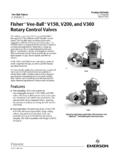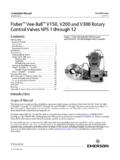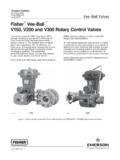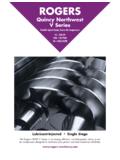Transcription of Overhaul Manual Vane Pumps - Eaton
1 M 2000 SRevised 11 01 85 Vane PumpsV100, V200, v300 , V400V500 and V2P SeriesOverhaul ManualVickers Vane Pumps2 EEaton Hydraulics, Incorporated 2000 All Rights Reserved3 Table of Purpose of Manual4.. B. General Information4.. General5.. B. Assembly and Construction5.. C. Flow Control and Relief Valve5.. D. Application5.. of OperationA. Pumping Cartridge6.. B. Hydraulic Balance6.. C. Pressure Plate6.. D. Flow Control and Relief Valve .. and Operating InstructionsA. Installation Drawings7.. B. Drive Connections7.. C. Shaft Rotation8.. D. Piping and Tubing8.. E. Hydraulic Fluid Recommendations8.. F. Overload Protection9.. G. Port Positions9.. H. Start-Up9.. , Inspection and MaintenanceA. Service Tools10.. B. Inspection10.. C. Adding Fluid to the System10.. D. Adjustments10.. E. Lubrication10.. F. Replacement Parts10.. G. Product Life10.. H. Troubleshooting Chart11.. General12.
2 B. Disassembly12.. C. Inspection and Repair12.. D. Assembly12.. 4 Section I IntroductionA. Purpose of ManualThis Manual has been prepared to assist the users ofVickers balanced vane type hydraulic single Pumps inproperly installing, maintaining and repairing their units. Inthe sections which follow, the single Pumps are described indetail, their theory of operation is discussed and instructionsare given for their proper installation, maintenance general series of models covered are V100, V200, v300 , V400, V500 and V2P. The information given applies tothe latest design configuration listed in Table 1. Earlierdesigns are covered only insofar as they are similar to thepresent General InformationRelated Publications Service parts information andinstallation dimensions are not contained in this Manual . Theparts catalogs and installation drawings listed in Table 1 areavailable from Codes There are many variations within each basicmodel series, which are covered by variables in the modelcode.
3 Table 2 is a complete breakdown of the code coveringthese units. Service inquiries should always include thecomplete unit model number, which is stamped on the No.(See Table 2)PartsCatalogInstallationDrawingV100 10M-2031-SM-152060V200 12M-2032-SM-190082V30011M-2033-SM-128797 V400 11M-2033-SM-127065V500 10M-1262-SM-236696V2P 10M-2002-SM-289405 Table 1. Parts Catalogs and Installation DrawingsOutlet portPressureplateBodyBearingsDriveshaftS ealInlet portPumpingcartridgeRotorVaneRingFigure valveFlow controlorifice5 Model CodeV 2 1 0 - 8 W - 1 F C - C 8 - 12 - L - *22456789131 Vane pump13123 SeriesBody Type1 Standard Threaded2 Standard Flange3 Face Threaded4 Face Flange5 Tapped Foot Threaded40 None4 Foot5 Flange7 Power Take-offMounting101114510 Capacity in GPM (@ 1200 RPM)6 Wide Ring (V200 only)71 Straight with Square Key3 Threaded6 Straight Stub with Woodruff Key7 Six-tooth Spline11 Splined24 Tang Drive34 Woodruff Key Threaded (Special)37 InvoluteSpline (Special)Shaft Type8 Connection Flanges Supplied9 Port Positions (see Figure 6)C 750 PSID 1000 PSIE 1250 PSIF 1500 PSIG 1750 PSIH 2000 PSIR elief Valve Setting (V200 only)11 Controlled Flow Rate (GPM)(V200 only)
4 12 Design1314 Optional Left Hand RotationSpecial FeaturesTable 2 Section II DescriptionA. GeneralPumps in this series are used to develop hydraulic fluid flow forthe operation of Mobile equipment. The positive displacementpumping cartridges are the rotary vane type with shaft sideloads hydraulically balanced. The flow rate depends on thepump size and the speed at which it is units are designed so that the direction of rotation,pumping capacity and port positions can be readily changedto suit particular Assembly and ConstructionThe V200 series pump illustrated in the cutaway in Figure 1is representative of all single Pumps in this series. The unitconsists principally of a ported body and cover, a drive shaftsupported by two ball bearings, a pumping cartridge and apressure plate. Components of the pumping cartridge are anelliptical cam ring, a slotted rotor splined to the drive shaftand twelve vanes fitted to the rotor the rotor is driven by the driveshaft, the vanes generatefluid flow by carrying fluid around the elliptical ring contour(see Section III).
5 Fluid enters the cartridge through the inletport in the body and is discharged through the pressure plateto the outlet port in the Flow Control and Relief ValveV200 Pumps are available with an integral flow control andrelief valve in the pump cover. This limits the final flow in thesystem to a maximum prescribed rate and preventsexcessive pressure buildup. Fluid not required in the systemis recirculated to ApplicationPump ratings in GPM as shown in the model coding are at1200 RPM. For ratings at other speeds, methods ofinstallation and other application information, Vickersapplication enginering personnel should be III Principles of OperationA. Pumping CartridgeAs mentioned in Section II, fluid flow is developed by thepumping cartridge. The action of the cartridge is illustrated inFigure 2. The rotor is driven within the cam ring by thedriveshaft, which is coupled to a power source. As the rotorturns, centrifugal force causes the vanes to follow theelliptical inner surface of the cam movement of the vanes and turning of the rotorcauses the chamber volume between the vanes to increaseas the vanes pass the inlet sections of the cam ring.
6 Thisresults in a low pressure condition which allows atmosphericpressure to force fluid into the chambers. (Fluid outside theinlet is at atmospheric pressure or higher.)This fluid is trapped between the vanes and carried past thelarge diameter or dwell section of the cam ring. As the outletsection is approached, the cam ring diameter decreases andthe fluid is forced out into the system. System pressure is fedunder the vanes, assuring their sealing contact against thecam ring during normal ringVaneOutletRotorDrive shaftInletOutletInletInletOutletFigure Hydraulic BalanceThe pump cam ring is shaped so that the two pumpingchambers are formed diametrically opposed. Thus, hydraulicforces which would impose side loads on the shaft Pressure PlateThe pressure plate seals the pumping chamber as shown inFigure 3. A light spring holds the plate against the cartridgeuntil pressure builds up in the system. System pressure iseffective against the area at the back of the plate, which islarger than the area exposed to the pumping cartridge.
7 Thus,an unbalanced force holds the plate against the cartridge,sealing the cartridge and providing the proper runningclearance for the rotor and Flow Control and Relief Valve1. Maximum flow to the operating circuit and maximumsystem pressure are determined by the integral flow controland relief valve in a special outlet cover used on some V200pumps. This feature is illustrated pictorially in Figure 4. Anorifice in the cover limits maximum flow. A pilot operated typerelief valve shifts to divert excess fluid delivery to tank, thuslimiting the system pressure to a predetermined systemeffective hereCoverPressure platePressure incartridgeSpringShaftRotorVaneRingDisch argeFigure Figure 4A shows the condition when the total pumpdelivery can be passed through the orifice. This conditionusually occurs only at low drive speeds. The large springchamber is connected to the pressure port through an plus spring load in this chamber slightly exceedspressure at the other end of the relief valve spool and thespool remains closed.
8 Pump delivery is blocked from thetank port by the spool When pump delivery is more than the flow ratedetermined by the orifice plug, pressure builds up across theorifice and forces the spool open against the light fluid is throttled past the spool to the tank port asshown in Figure If pressure in the system builds up to the relief valvesetting (Figure 4C), the pilot poppet is forced off its in the large spring chamber flows through the spool andout to tank. This flow causes a pressure differential on thespool, shifting it against the light spring. All pump delivery isthus permitted to flow to springholds reliefvalve closedwhen pressureis equal onboth endsPilot poppetTotankSpool blockstank port offRelief valvespringSystempressuresensed inspringchamberthroughorificePressurepor tOrificedeterminesflow rateDeliveryfrompumpingcartridgeTotankPr essureportTotankPressureportExcess fluidthrottled pastvalve to tankPressure in springchamber lowerthan system dueto pressure dropacross sensingorificePoppetforcedoff seat asrelief valvesetting isreachedSpringorificeFigure 4 ALow Drive Speed All PumpDelivery to SystemFigure 4 BNormal OperationFigure 4 CExcessive PressureBuild-Up in SystemSection IV Installation and Operating InstructionsA.
9 Installation DrawingsThe Installation Drawings listed in Table 1 show the correctinstallation dimensions and port Drive ConnectionsCAUTIONPump shafts are designed to be installed in couplings,pulley, etc., with a slip fit or very tight tap. Poundingcan injure the bearings. Shaft tolerances are shownon pump installation drawings. (See Table 1.)1. Direct Mounting A pilot on the pump mountingflange (Figure 5) assures correct mounting and shaftalignment. Make sure the pilot is firmly seated in theaccessory pad of the power source. Care should beexercised in tightening the mounting screws to gaskets are used, they should be installed carefully andshould lay flat. Shaft keys and couplings must be properlyseated to avoid slipping and possible 52. Indirect Drive Chain, spur gear or v-belt pulleydrives may also be used with these Pumps . Flat belt drivesare not recommended because of the possibility of prevent excessive side loads on pump bearings, it isimportant to check for correct alightment and guard againstexcessive belt or chain Shaft RotationPumps are normally assembled for right-hand (clockwise)rotation as viewed from the shaft end.
10 A pump made forleft-hand rotation is identified by an L in the model code(see Table 2).NOTET hese Pumps must be driven in the direction of thearrows cast on the pump ring. If it is desired tochange the direction of drive rotation, it is necessaryto reverse the ring (see Section VI, B D and Figure9).CAUTIONN ever drive a pump in the wrong direction ofrotation. Seizure may result, necessitatingexpensive Piping and Tubing1. All pipes and tubing must be thoroughly cleanedbefore installation. Recommended methods of cleaning aresand blasting, wire brushing and instructions on pickling refer to instruction To minimize flow resistance and the possibility ofleakage, only as many fittings and connections as arenecessary for proper installation should be The number of bends in tubing should be kept to aminimum to prevent excessive turbulence and friction of oil must not be bent too sharply. Recommended radius forbends is three times the inside diameter of the Hydraulic Fluid RecommendationsFluid in a hydraulic system performs the dual function oflubrication and transmission of power.

















